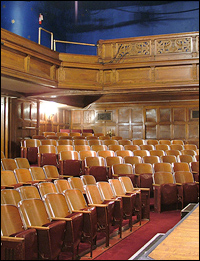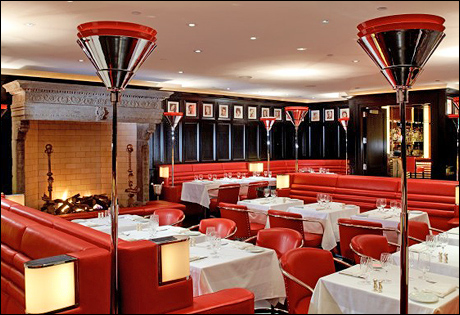
*
Ask Playbill.com answers your (and sometimes our own) theatre-related questions. To ask a question, email [email protected]. Please specify how you would like your name displayed and please include the city in which you live.
Question: I just enjoyed dinner at a handsome new West 44th Street restaurant called The Lambs Club. The next day, a friend reminded me that we had attended plays on the site at the Lamb's Theatre (I think) in the same building. I recall a gorgeous oaken interior unlike any other in New York City. Are the design elements of the theatre in storage? Was it gutted? Is the theatre still in that building? — A.E., Levittown, NY
In August, the 1904 building on West 44th Street between Sixth and Seventh Avenue — which once housed the New York branch of the once famed Lamb's Club theatrical fraternity — reopened after years of construction as The Chatwal, a luxe hotel. On the ground and second floors are a high-end restaurant and bar called the Lambs Club. (In its conversion, the space lost its apostrophe. The actual Lamb's Club organization still exists, but it is located on East 51st Street.)
The address' theatrical legacy was deep. The Lamb's Club was founded in London in 1869; the American version arrived in 1874. The club was apparently named after Charles and Mary Lamb. Charles was a dramatic critic who hosted many theatre types at salons in his home back in the 19th century. Every important American actor and writer you can think of was once a member of the American branch of the Lamb's, including Irving Berlin, Fred Astaire, Bert Lahr, David Belasco, Oscar Hammerstein II, Richard Rodgers, Charlie Chaplin, Jack and Lionel Barrymore and Douglas Fairbanks, Jr. Composing team Alan J. Lerner and Frederick Loewe reportedly met at the Lamb's. Asked to draw a distinction between The Lamb's, the Friars Club, and The Players, playwright George S. Kaufman once quipped, "The Players are gentlemen trying to be actors, the Lambs are actors trying to be gentlemen, and the Friars are neither trying to be both."
| |
 |
|
| Inside the Lambs Theatre, prior to its 2007 closing and later demolition. |
Carolyn Copeland, who founded the Lambs Theatre Company in 1979, was intimately involved in the the small theatre's renovation, and its operations during its final years, up until its destruction. "We left when we had to move out in January 2007," due to the coming construction of the hotel, she said. "We had to be out of the building. We fought against it, but we lost. We just just wanted to keep the theatre. It was a beautiful theatre. The pecan paneling and the gorgeous interior."
Copeland said she and others tried to save the theatre, but to no avail. "The exterior was landmarked but not the interior. That was the big downfall." Learning that the entire space would be destroyed, she called on friends and colleague to take whatever they could of the theatre's accoutrements. "I gave everything away. The last few days we had people come and take the paneling and seats. It was so sad. We tried to get rid of as much of it as we could. They didn't want it. It was going in truck. It was going to be demolished. There were no plans to keep any of that."
While the theatre, and much of the rest of the original club is gone, certain architectural details remain. According to Kristen Steglich, a spokesperson for the new restaurant, these include the first-floor 18th-century French fireplace in The Lambs Club dining room (a gift from Stanford White to the Lambs); The World War I & II memorial and fireplace near the elevator bank; the four original Grill Room doors, which were reintroduced and restored (two more were replicated); and the building's fully restored facade, which is landmarked. Also the Stanford White Studio was originally the Lambs' library. Copeland, moreover, has heard that her former office is now "a great suite." The new restaurant and bar, meanwhile, have been given a lush, Art Deco design, with red, black and silver the dominant colors.
Steglich also pointed out that the Lambs is holding on to theatrical roots by attracting a pre-theatre and post-theatre dinner crowd. The restaurant also serves breakfast, lunch, brunch and will be introducing afternoon tea soon. The cocktail program was created by noted mixologist and bar owner Sasha Petraske.
 |
| The current Lambs Club restaurant. |










